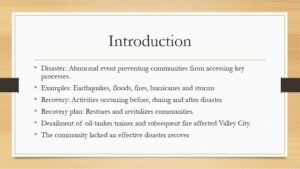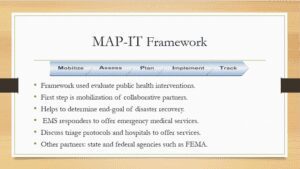Develop a disaster recovery plan to lessen health disparities and improve access to community services after a disaster. Then, develop and record a 10-12 slide presentation (please refer to the PowerPoint tutorial) of the plan with audio and speaker notes for the Vila Health system, city officials, and the disaster relief team. Disaster Recovery Plan Disaster Recovery Plan As you prepare this assessment, you are encouraged to complete the Disaster Preparedness and Management activity. The information gained from completing this activity will help you succeed with the assessment as you consider critical disaster preparedness and management issues in the community or workplace. Completing activities is also a way to demonstrate engagement. Professional Context Nurses perform a variety of roles, and their responsibilities as healthcare providers extend to the community. The daily decisions and crises often involve balancing human rights with medical necessities, equitable access to ser
Disaster Recovery Plan

Hello, and welcome to this disaster recovery presentation. I hope you will learn about my disaster recovery plan. This presentation will develop a disaster recovery plan for the provided Vila Health community to reduce health disparities and elevate access to care.

A disaster is any regular activity that prevents individuals from accessing key processes. Recovery is a set of activities that happen before, during, and after the disaster. Disaster commonly co-occurs with emergency response activities. The disaster recovery plan aims to restore and revitalize communities impacted by a disaster (Finucane et al., 2020). Natural disasters include hurricanes, storms, lightning, air crashes, floods, fires, and earthquakes. One community affected by a disaster is the Villa Health community, which was affected by a derailed oil tanker trained. The community did not have the necessary measures to respond to such a disaster. After conversing with community and hospital officials, their disaster recovery plan should be updated.

Map-IT framework from the Healthy People 2020 is a framework that can be used in the planning and evaluation of public health programs, including disaster recovery. The first step in this framework is mobilizing collaborative partners (Buns et al., 2017). This step helps to determine the end objective of the recovery plan. In the case of Valley City, a derailed oil tanker caused an explosion and fire. The first step should be collaborating with local EMS responders to formulate a plan to reach and offer emergency services to individuals affected by the fire and those needing medical attention. This collaborative process should discuss triage protocols and the hospitals to receive critical patients. Furthermore, a search and rescue team should be in place to look for individuals who cannot be traced. Other partners will be state and federal government agencies, such as FEMA, who can offer additional help.

The second step is to assess community needs and resources. This will help determine real needs and give a reality check on what can be achieved (Buns et al., 2017). This will address individuals affected by the disaster, available resources, and resources needed. The collaborative partners will work to set priorities and allocate resources to meet these priorities. Community leaders include EMS supervisors, senior hospital management, utility company leaders, and elected officials. The Villa Health community is diverse with unique needs. There is a high number of older adults living in nursing homes. These persons will require medicines for their chronic conditions. The community also has a higher number of low-income uninsured individuals. Many homeless individuals will also require shelter in case of a disaster as fire erupts.

The third step is the planning phase. This will involve developing an action plan with definitive steps and plans (Buns et al., 2017). In this phase, the vision of the recovery plan and clear goals will be set to help achieve the plan. The objectives should be specific to the needs of the Villa Health community and address the recovery plan’s goal. This will include what is required to achieve the goals and ways of measuring progress to determine if the goal has been achieved. The action plan will include action steps such as EMS responding in case of an explosion and how to triage. All members of the rescue team will be assigned responsibility. In addition, it will show how to collect information and a feasible timeline for the recovery plan. The objectives will be clear and realistic. A target should also be set. The action plan should indicate individuals responsible for each step with defined roles. A command center will be developed, and it will have EMS responders. The command center will be responsible for mobilizing first-time responders. Vulnerable areas such as nursing homes will have first-time responders. Proper triage training should be done, and hospitals should be on standby to receive fire victims.

The fourth step is implementing strategies and steps i
Order this paperDevelop a disaster recovery plan to lessen health disparities and improve access to community services after a disaster. Then, develop and record a 10-12 slide presentation (please refer to the PowerPoint tutorial) of the plan with audio and speaker notes for the Vila Health system, city officials, and the disaster relief team. Disaster Recovery Plan Disaster Recovery Plan As you prepare this assessment, you are encouraged to complete the Disaster Preparedness and Management activity. The information gained from completing this activity will help you succeed with the assessment as you consider critical disaster preparedness and management issues in the community or workplace. Completing activities is also a way to demonstrate engagement. Professional Context Nurses perform a variety of roles, and their responsibilities as healthcare providers extend to the community. The daily decisions and crises often involve balancing human rights with medical necessities, equitable access to ser
Disaster Recovery Plan

Hello, and welcome to this disaster recovery presentation. I hope you will learn about my disaster recovery plan. This presentation will develop a disaster recovery plan for the provided Vila Health community to reduce health disparities and elevate access to care.

A disaster is any regular activity that prevents individuals from accessing key processes. Recovery is a set of activities that happen before, during, and after the disaster. Disaster commonly co-occurs with emergency response activities. The disaster recovery plan aims to restore and revitalize communities impacted by a disaster (Finucane et al., 2020). Natural disasters include hurricanes, storms, lightning, air crashes, floods, fires, and earthquakes. One community affected by a disaster is the Villa Health community, which was affected by a derailed oil tanker trained. The community did not have the necessary measures to respond to such a disaster. After conversing with community and hospital officials, their disaster recovery plan should be updated.

Map-IT framework from the Healthy People 2020 is a framework that can be used in the planning and evaluation of public health programs, including disaster recovery. The first step in this framework is mobilizing collaborative partners (Buns et al., 2017). This step helps to determine the end objective of the recovery plan. In the case of Valley City, a derailed oil tanker caused an explosion and fire. The first step should be collaborating with local EMS responders to formulate a plan to reach and offer emergency services to individuals affected by the fire and those needing medical attention. This collaborative process should discuss triage protocols and the hospitals to receive critical patients. Furthermore, a search and rescue team should be in place to look for individuals who cannot be traced. Other partners will be state and federal government agencies, such as FEMA, who can offer additional help.

The second step is to assess community needs and resources. This will help determine real needs and give a reality check on what can be achieved (Buns et al., 2017). This will address individuals affected by the disaster, available resources, and resources needed. The collaborative partners will work to set priorities and allocate resources to meet these priorities. Community leaders include EMS supervisors, senior hospital management, utility company leaders, and elected officials. The Villa Health community is diverse with unique needs. There is a high number of older adults living in nursing homes. These persons will require medicines for their chronic conditions. The community also has a higher number of low-income uninsured individuals. Many homeless individuals will also require shelter in case of a disaster as fire erupts.

The third step is the planning phase. This will involve developing an action plan with definitive steps and plans (Buns et al., 2017). In this phase, the vision of the recovery plan and clear goals will be set to help achieve the plan. The objectives should be specific to the needs of the Villa Health community and address the recovery plan’s goal. This will include what is required to achieve the goals and ways of measuring progress to determine if the goal has been achieved. The action plan will include action steps such as EMS responding in case of an explosion and how to triage. All members of the rescue team will be assigned responsibility. In addition, it will show how to collect information and a feasible timeline for the recovery plan. The objectives will be clear and realistic. A target should also be set. The action plan should indicate individuals responsible for each step with defined roles. A command center will be developed, and it will have EMS responders. The command center will be responsible for mobilizing first-time responders. Vulnerable areas such as nursing homes will have first-time responders. Proper triage training should be done, and hospitals should be on standby to receive fire victims.

The fourth step is implementing strategies and steps i
Order this paper